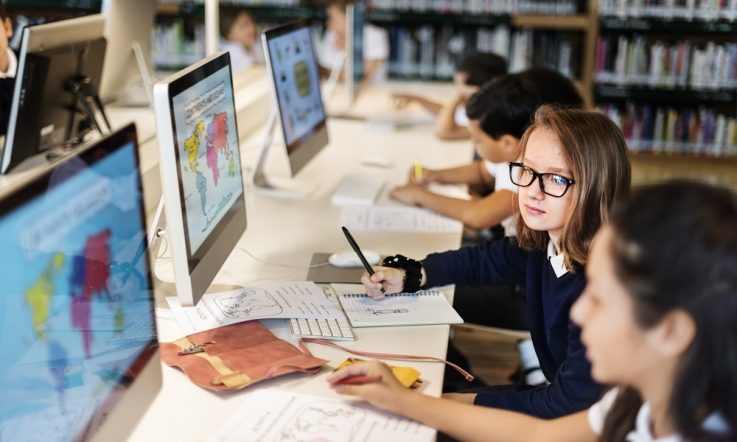Educating students for their future, not our past
It's so much easier to educate students for our past, than for their future. Schools are inherently conservative social systems, as parents we get nervous when our children learn things we don't understand, and even more when they no longer study things that were important for us.
Teachers are more comfortable teaching how they were taught than how they were taught to teach. And politicians can lose an election over education issues but rarely win one over education, because it takes way more than an election cycle to translate good intentions into better results.
The biggest risk to schooling today isn't its inefficiency, but that our way of schooling is losing its purpose and relevance. And when fast gets really fast, being slower to adapt makes education systems quickly disoriented. We live in a world in which the kinds of things that are easy to teach and test have also become easy to digitise and automate.
These days, digitalisation is connecting people, cities, countries and continents in ways that vastly increase our individual and collective potential. Any one of us can now change the world, for better or worse. And together, we can address the world's biggest challenges. But digitalisation has also made the world more complex, more volatile and more uncertain.
Digitalisation can be incredibly democratising – we can connect and collaborate with anyone – but digitalisation can also concentrate incredible powers. Digitalisation can be incredibly particularising – the smallest voice can be heard everywhere – but it can also be incredibly homogenising, squashing individuality and cultural uniqueness.
These days, algorithms sort us into groups of like-minded individuals and create social media echo chambers that amplify our views, but leave us insulated from opposing arguments that could question our beliefs. These virtual bubbles homogenise opinions and polarise our societies. Digitalisation can be incredibly empowering, the most powerful companies these days start with a big idea, not with a big industry; they have the product before they have the money. But it can also be incredibly disempowering, when we end up following the dictates of some computer algorithm.
It's our knowledge, skills, attitudes and values that determine where we come out on these issues. It's all about human capabilities.
Moving beyond content knowledge
When we could still assume that what we learn in school will last for a lifetime, teaching content knowledge and routine cognitive skills was rightly at the centre of education. Today, the world no longer rewards us just for what we know – Google knows everything – but for what we can do with what we know. The more knowledge that technology allows us to search and access, the more important becomes deep understanding and the capacity to make sense out of content.
Understanding involves knowledge and information, concepts and ideas, practical skills and intuitions. But fundamentally, it involves bringing them together, integrating and applying them. And in a structurally imbalanced world, the imperative of reconciling diverse perspectives and interests requires people to become adept in handling tensions and dilemmas; striking a balance between competing demands – equity and freedom, autonomy and community, or innovation and continuity.
Tomorrow's schools need to help students think for themselves and join others in work and citizenship. They need to help students develop a strong sense of right and wrong and sensitivity to the claims that others make. At work, at home and in the community, people will need a deep understanding of how others think, whether as scientists or artists, and how others live, in different cultures and traditions.
Whatever tasks machines may be taking over from humans at work, the demands on our capabilities to contribute meaningfully to social and civic life will always keep rising. These are the topics that dominate issues around curriculum design in the most advanced education systems.
Thinking framed by myths
One of the reasons why we get stuck in education is that our thinking is framed by so many myths.
The poor will always do badly in school. That's not true: the 10 per cent most disadvantaged 15-year-olds in Shanghai did better on the PISA maths test than the 25 per cent wealthiest Australian students.
Immigrants will lower the performance of a country on international comparisons. That's not true: there is no relationship between the share of immigrants and the quality of an education system, and the school systems where immigrant students settle matters a lot more than the country where they came from. Australia is a great example of a country where immigrant students succeed.
Smaller classes automatically mean better results. That's not true: in fact, whenever high-performing education systems have to make a choice between a smaller class and a better teacher, they go for the latter. Singapore has a student/staff ratio of 12, more favourable than that in Australia, and yet, Singapore has much larger classes (34) than Australia (25). What looks like a statistical fluke has a lot of practical implications. Teachers in Australia have little time for other things than teaching, while the larger class sizes in Singapore allow teachers to spend much more time with their colleagues to observe other teachers' practice and work collaboratively on new practice. Often, it is small classes that have created the ‘tailoristic' culture where teachers end up doing little else than teaching, and don't have the time for individual student support, collaboration with other teacher professionals, or working with parents – the hallmarks of high-performing education systems.
More time spent learning always means better results. That's not true: study hours in Finland are little more than half what students in the United Arab Emirates spend, but in Finland students learn a lot in little time while in the UAE they learn very little in a lot of time.
The good news is that our knowledge about what works in education has improved vastly. The first thing is that leaders in high-performing education systems have convinced their citizens to value the future. Chinese parents and grandparents will invest their last money into their future, the education of their children. In Europe we have already spent the money of our children for our own consumption.
But valuing education highly is just part of the equation. Another part is the deep belief that every student can learn, and to realise that ordinary students can have extraordinary talents.
Looking outwards, not upwards
And nowhere does the quality of a school system exceed the quality of its teachers. Top school systems select and educate their teaching staff carefully. They provide an environment in which teachers work together to frame good practice, and they encourage teachers to grow in their careers.
Top-performing school systems have also advanced from administrative control and accountability to professional forms of work organisation. They encourage their teachers to be innovative, to improve their own performance and that of their colleagues, and to pursue professional development that leads to better practice. In top school systems, the emphasis is not on looking upwards within the administration of the school system. Instead it's about looking outwards to the next teacher or the next school, creating a culture of collaboration and strong networks of innovation.
And the best-performing school systems provide high-quality education across the entire system so that every student benefits from excellent teaching. To achieve this, these countries attract the strongest principals to the toughest schools and the most talented teachers to the most challenging classrooms.
Still, knowledge is only as valuable as our capacity to act on it and the road of educational reform is littered with good ideas that were poorly implemented. The laws, regulations, structures and institutions on which educational leaders tend to focus are just like the small visible tip of an iceberg.
The reason why it is so hard to move school systems is that there is a much larger invisible part under the waterline. This invisible part is about the interests, beliefs, motivations and fears of the people who are involved in education (parents and teachers included). This is where unexpected collisions occur, because this part of educational reform tends to evade the radar screen of public policy. That is why educational leaders are rarely successful with reform unless they build a shared understanding and collective ownership for change, and unless they build capacity and create the right policy climate, with accountability measures designed to encourage innovation rather than compliance.
Many teachers and schools are ready for that. To encourage their growth, policy needs to shift toward inspiring and enabling innovation, identifying and sharing best practice. In traditional bureaucratic school systems, teachers are left alone in classrooms with plenty of prescription what to teach. Future teachers and schools are looking outwards to collaborate with the next teacher and the next school.
Schools in the past and the future
The past was about delivered wisdom, the future is about user-generated wisdom. The past was divided – we had teachers and content divided by subjects and student destinations; and the past was isolated – schools were designed to keep students inside, and the rest of the world outside.
The future needs to be integrated. That means emphasising integration of subjects, integration of students and integration of learning contexts; and it needs to be connected – that means connected with real-world contexts, and also permeable to the rich resources in the community.
Instruction in the past was subject-based, instruction in the future will be project-based. The past was hierarchical – students were recipients and teachers the dominant resource; the future is co-created, and that means we need to recognise both students and adults as resources for the co-creation of communities, for the design of learning and for the success of students.
The future also needs to be collaborative, and that means changing working norms. Expressed differently, we are seeing a shift from a world of stocks – with knowledge that is stacked up somewhere depreciating rapidly in value – to a world in which the enriching power of collaboration is rising.
The goals of the past were standardisation and compliance, that is, students are educated in batches of age, following the same standard curriculum, all assessed at the same time. The future is about personalising educational experiences, that is, building instruction from student passions and capacities, helping students personalise their learning and assessment in ways that foster engagement and talents.
In the past, schools were technological islands, that is, technology was deployed mostly to support existing practices for efficiency gains. Future schools are empowered and use the potential of technologies to liberate learning from past conventions and connect learners in new and powerful ways. The past was interactive, the future is participative. We need to understand that learning is not a place, but an activity.
The future is also about more innovative partnerships. Isolation in a world of complex learning systems will seriously limit potential. Powerful learning environments are constantly creating synergies and finding new ways to enhance professional, social and cultural capital with others. They do that with families and communities, with higher education, with other schools and learning environments, and with businesses.
But in the face of all these challenges we don't need to be passive. While technology and globalisation have disruptive implications for our economic and social structure, they don't have predetermined implications. It is the nature of our collective responses to these disruptions that determines their outcomes – it's the interplay between the technological frontier and the cultural, social, institutional and economic agents that we mobilise in response.
This article builds on World Class – how to build a 21st century school system.



